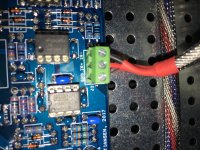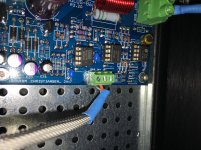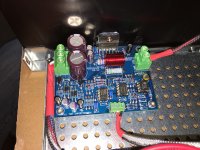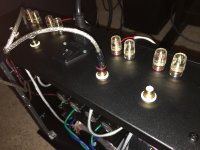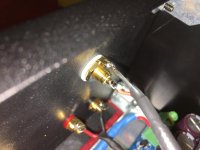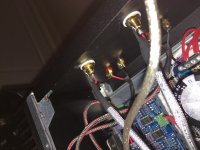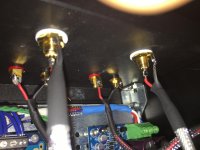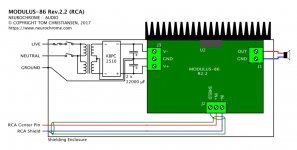I tried grounding rca shield to chassis to see if it would help or make a difference.
Right now the amp is connected internally how it's recommended in tomchr's pdf. That is to say that the center pin goes to input +, the shield tab goes to both the input - and input gnd. I tried disconnecting the gnd, tried going shield only to negative, shield only to ground. Nothing helped.
Right now the amp is connected internally how it's recommended in tomchr's pdf. That is to say that the center pin goes to input +, the shield tab goes to both the input - and input gnd. I tried disconnecting the gnd, tried going shield only to negative, shield only to ground. Nothing helped.
Last edited:
RCAs:
Attachments
So I removed the miniDSP, added a cap and coil to my speakers, and ran full range in and out of the amp from my phone. Playing lossless files, holy s--- does it sound good!
And not a hint of noise. Perfect silence, can't hear the speakers even with my ear up to them.
Man, the treble is just superbly fluid, precise, and delicate. Cymbal crashes flourish and decay endlessly into the abyss.
Damn, I love this amp when it gets along with my stuff.
Reminds me of when I got my first glasses as a kid. Didn't realize until I had them how much I was missing.
And not a hint of noise. Perfect silence, can't hear the speakers even with my ear up to them.
Man, the treble is just superbly fluid, precise, and delicate. Cymbal crashes flourish and decay endlessly into the abyss.
Damn, I love this amp when it gets along with my stuff.
Reminds me of when I got my first glasses as a kid. Didn't realize until I had them how much I was missing.
RCAs:
In the first pic at the top left you have red wire connected to IN+
Black wire is connected to IN-
Shield is connected to GND
In the pic at the far right top you have red wire soldered to the IN+
Shield is soldered to GND washer, and while I cannot see it you've written that the black wire is also soldered to the GND washer.
IN- is NOT GND. IN- is the bottom half of the input signal sine wave.
Your hum issue is because you have IN- wire soldered to GND. It will give a big loud hum whenever anything is plugged into that rca.
You need to get with Tom Christiansen to get proper connection for IN-.
Damn, I love this amp when it gets along with my stuff.
Reminds me of when I got my first glasses as a kid. Didn't realize until I had them how much I was missing.
Awesome. It brings a big smile to my face that you got it working and like it. Feel free to leave a review on my website if you feel like it.
Should you need more help, I'm always available through email. Take my username here and add @neurochrome.com to reach me directly.
Tom
In the first pic at the top left you have red wire connected to IN+
Black wire is connected to IN-
Shield is connected to GND
For a differential connection, that's true. For a pseudo-differential, the black goes to the RCA shield. As does the GND. I can't tell 100 % from the pictures if the black wire goes to the RCA shield. It should...
You'll get the best performance with a differential connection, but the single-ended (RCA) will work as well.
Tom
For a differential connection, that's true. For a pseudo-differential, the black goes to the RCA shield. As does the GND. I can't tell 100 % from the pictures if the black wire goes to the RCA shield. It should...
You'll get the best performance with a differential connection, but the single-ended (RCA) will work as well.
Tom
Fair enough.
How come I cannot access your website? I get the unsupported protocol screen and cannot access.
If this were my board, I would try two things:
1) Place 1K resistors in series with both the plus and minus inputs at the modulus input connector. See if hum decreases/disappears.
2) if that doesn't work, then try this: Connect the black wire and shield AND one leg of a 100K resistor to the minus input and the other leg of the resistor to the ground input on the modulus input connector.
Both of these approaches are trying to isolate the negative input of the differential amplifier from the ground loop issues. One of them hopefully will work for you.
1) Place 1K resistors in series with both the plus and minus inputs at the modulus input connector. See if hum decreases/disappears.
2) if that doesn't work, then try this: Connect the black wire and shield AND one leg of a 100K resistor to the minus input and the other leg of the resistor to the ground input on the modulus input connector.
Both of these approaches are trying to isolate the negative input of the differential amplifier from the ground loop issues. One of them hopefully will work for you.
If you look closely at the black wires soldered to the shield tabs, you can see strands of the ground wire running right next to them soldered to the same point.
I did this per tomchr's instructions here:
I saw that, but on the offchange that the RCAs are accidentally also connecting to the case a flying lead direct to the miniDSP is a worthwhile check. We know that works as miniDSP is used quite a bit with the Mod-86.
Ok,
First I'd like to thank everyone for their contributions and effort. None of you get paid for what you do here, so I hope it's at least been interesting and fun.
Second, I've discovered a phenomenon I simply can't explain. I left the amp playing all night last night in the garage because I was simply too tired late in the night to have remembered to go back and turn it off after I made a trip to the loo.
I came back in to check on it this morning after I noticed sound coming from the direction of the garage. I walked in and listened for a bit and thought "sure sounds great, wish it didn't have noise." I turned the volume down in preparation to shut everything off and didn't hear anything.
After a good 15 minutes of touching, adjusting, turning on and off, and general screwing-around-with this morning... I've discovered I now have an amp that is near-silent. The little bit of noise that's left is low enough that I can't hear it any further away than about 2 feet from the speakers.
I swear to all that is holy I didn't change a thing from the last time I heard noise in this system. All I did is let it play overnight.
I've just moved it back into my listening room, and it's still working great connected to PC, miniDSP.
All I can do right now is shake my head, call myself lucky, and thank all of you.
And Tom, great work. As I said, these amp boards sound fantastic.
First I'd like to thank everyone for their contributions and effort. None of you get paid for what you do here, so I hope it's at least been interesting and fun.
Second, I've discovered a phenomenon I simply can't explain. I left the amp playing all night last night in the garage because I was simply too tired late in the night to have remembered to go back and turn it off after I made a trip to the loo.
I came back in to check on it this morning after I noticed sound coming from the direction of the garage. I walked in and listened for a bit and thought "sure sounds great, wish it didn't have noise." I turned the volume down in preparation to shut everything off and didn't hear anything.
After a good 15 minutes of touching, adjusting, turning on and off, and general screwing-around-with this morning... I've discovered I now have an amp that is near-silent. The little bit of noise that's left is low enough that I can't hear it any further away than about 2 feet from the speakers.
I swear to all that is holy I didn't change a thing from the last time I heard noise in this system. All I did is let it play overnight.
I've just moved it back into my listening room, and it's still working great connected to PC, miniDSP.
All I can do right now is shake my head, call myself lucky, and thank all of you.
And Tom, great work. As I said, these amp boards sound fantastic.
Two things spring to mind when you told me this. The first thing is that you may have a bad capacitor somewhere and it charged up by being on for an extended period of time. The other thing that comes to mind is a thermally related issue where once things warmed up they expanded and a connection was made perhaps a bad resistor somewhere. When I have these sorts of problems I cool the unit down and then use a heat gun at certain spots to find the problem. If your problem doesn't return then all is good.
- Status
- This old topic is closed. If you want to reopen this topic, contact a moderator using the "Report Post" button.
- Home
- Amplifiers
- Solid State
- Why not ground everything straight to chassis?
